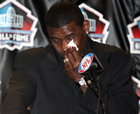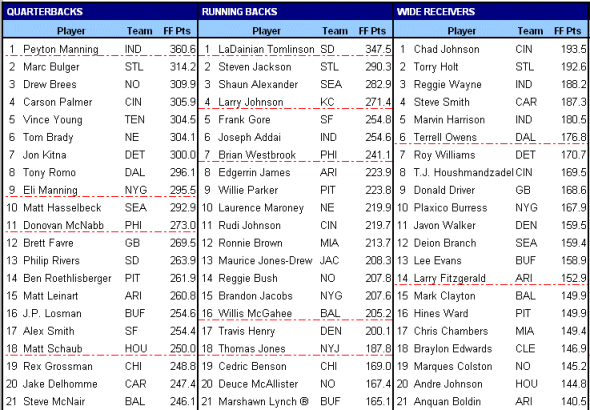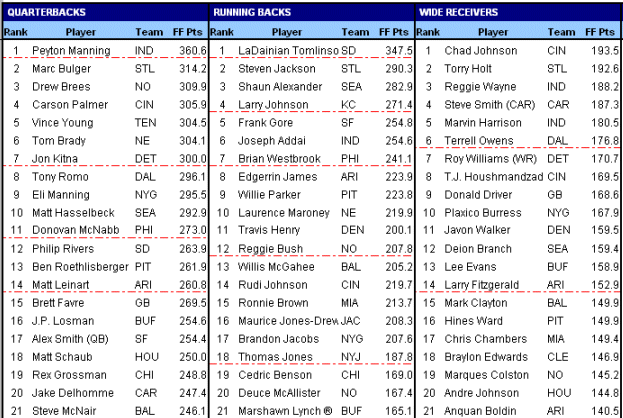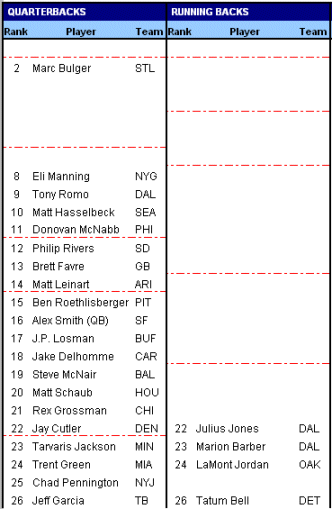8/16/07
 As
Dick Vermeil showed
us, and more recently Michael Irvin, there is crying in football. As
Dick Vermeil showed
us, and more recently Michael Irvin, there is crying in football.
What about fantasy football? Is there crying in fantasy football?
There's heartbreak, jubilation, frustration, good fortune, second-guessing,
and hopefully at the end of the day, triumph. Tears? I've never
shed a tear. (Swearing is a whole different story.) There is in
fact, no crying in fantasy football. At draft time though, there
are tears. I mean, Tiers. And these Tiers are going to
set you up, with a little good fortune, on the path to triumph.
What Is Tiering?
Tiering is the concept of grouping players together on a cheatsheet
who have similar projected performance. Since I wrote my
first article about tiering back in 2004, many more people
have written about it and it has become a commonly used strategy
by fantasy players. However, that 2004 article is still the article
I refer more people to than any other fantasy football article
by a long shot. Why? Because obviously many people still don't
know what it is, and Tiering is that good.
Grouping players converts an otherwise typical cheatsheet in
which players are ranked 1, 2, 3, 4, etc. to one that shows where
the significant drop-offs in performance are expected at each
position. Tiering highlights that there are X number of players
at a position in Tier 1 (the top tier), Y players in Tier 2 (next
tier), etc. so you can judge whether a position has good quality
depth, or not so good quality depth.
The significance of this should be obvious. Positions that have
shallow depth, you need to go after earlier in your draft, or
pay more for at auction. Positions where there is deep depth,
you can wait on until later in the draft. Players in the same
tier represent players who you should be more or less indifferent
about. Of course everyone has preferences about players, but if
I feel Jon Kitna is essentially a wash in points with Drew Brees,
and Kitna can be acquired 2+ rounds later than Brees, I should
be much better off having acquired Kitna. I've used the earlier
picks when I passed on Brees, on better, higher tier players at
other positions.
The end result? Again, this should be obvious: You will have
a much stronger team to go battle with this season against your
competition.
Creating Tiers
To create tiers, there are two steps. The first is purely mathematical.
It involves calculating drop-offs based on the projected fantasy
points that helped develop the initial player rankings on your
cheatsheet. The second step is more subjective. It involves re-ranking
some players after being pushed through the projections, based
on risk, upside, etc., and also adjusting the tiers as you feel
are appropriate, based on your own judgment.
For the mathematical step, the calculations are pretty straight
forward. This is all automated in the Cheatsheet
Compiler, but to do it yourself, all you need to do is decide
on a number at which point you think there is a significant enough
drop-off to warrant a new tier, deduct it from the projected fantasy
points of the top ranked player at a position to calculate the
Tier 1 lower limit, and draw a line under the last player who's
projected fantasy points are within the lower limit. Then repeat
the same process for the next tier, and the next, working down
the rankings for each position.
In a typical standard performance scoring system (1 per 20 passing
yards, 1 per 10 rushing or receiving yards, 4 to 6 points per
TD) I find 20 fantasy points works well, or 1.25 fantasy points
per game. Here is an example cheatsheet based on FF Today's default
scoring. The Tiers are indicated by the dotted red lines using
20 fantasy points.

This looks pretty good before we even make any adjustments. Peyton
Manning is in a QB class by himself, as is LaDainian Tomlinson
amongst RB. For QB, Tier 2 is maybe a little wide. Typically people
would have Bulger, Brees, Palmer and Brady separated from the
others based on them having lower risk.
The RB after LT go into a group of 3: 20+ TD potential guys as
Tier 2, another 3: all the tools but some uncertainty as Tier
3, and then a much deeper RB tier of 9 players who have been picked
very interchangeably in the drafts I've looked at and participated
in, as Tier 4.
There isn't a lot of consensus about the top receivers this year,
other than thinking any of those first 6 could arguably land in
the #1 WR spot. This is Tier 1 for WR. Then 8 WR make up Tier
2 who have generally been consistently good, followed up by a
similarly deep Tier 3 where the players have a few more warts,
like Chris Chambers, or concerns of being a one-hit wonder, like
Marques Colston.
As for picking 20 as the magic number, there is not a hard rule
on this because different fantasy scoring systems will yield different
results. To assess what is right for you, pick a number like 20
and push the calcs. Then review the tiers and see if they provide
a reasonable distribution of players as analyzed above. Can you
reasonably make a case that the bottom guy in a tier has the same
ballpark expectations for the season as the top guy in the same
tier? Is there a noticeable drop in talent, opportunity, upside
or risk from players in one tier to the next? If yes, then you
likely have your tiers at or pretty close to where you want them.
Remember at this point you don't need to agree with where every
single tier line falls. There can be some finessing if you like.
In this case, I do think Tier 2 for QB is a bit wide. I'm going
to cutoff the second tier between Kitna and Tony Romo. I'm also
tempted to re-rank Rivers, Roethlisberger and Leinart ahead of
Favre, and create a new tier between Leinart and Favre.
I like how the top 3 tiers are set out at RB. I disagree with
Mike Krueger's projections of Travis Henry, thinking they are
a bit low. I'm moving him up to the 11th spot on my sheet, McGahee
12th and Bush 13th, and mark a tier line under Bush.
The WR rankings I'm going to leave as is. Here is the revised
cheatsheet:

Even after my adjustments, there will be some questioning of why,
for example, Mark Clayton is not in the same tier as Larry Fitzgerald
when there is only 3 fantasy points difference between them? That
isn't the way to look at it. We don't focus our attention on the
specific player names and fantasy points at this stage. I could
have in fact taken the fantasy points out of this cheatsheet.
What we need to focus on now are the groupings of players. By
accepting a tier line there, I'm saying there is a significant
enough difference between expectations and risk of the players
in Tier 2 (Fitzgerald's tier) and expectations and risk of players
in Tier 3 (Clayton's tier) to warrant them being in separate groups.
Since these are my rankings, then I should be able to make similar
assessments at each place I've marked a new tier. Now my tiered
cheatsheet is complete, let's draft.
Theory Meets Reality
 Here
is a situation I faced recently in a keeper league draft. Marc
Bulger is sitting all alone as a Tier 2 QB, while the RB position
has been depleted down to players ranked in the 20s. I could use
another RB. I don't have a starting QB either, but I usually love
waiting on the QB position until late. Here
is a situation I faced recently in a keeper league draft. Marc
Bulger is sitting all alone as a Tier 2 QB, while the RB position
has been depleted down to players ranked in the 20s. I could use
another RB. I don't have a starting QB either, but I usually love
waiting on the QB position until late.
As tempting as it is to add potential TD machine Marion Barber
here, relying on my tiers, Bulger is the pick. Taking Bulger now
enhances the whole starting lineup much more than Barber or the
other RB in his tier.
Bulger not only provides a clear advantage over the other teams
in the league that still need to draft a QB, but also playing
the odds, one of the RB could likely be available at my next pick.
It may not be Barber, but the way my tiers are laid out, drafting
Tier 2 QB + Tier 6 RB is clearly better than drafting Tier 6 RB
+ Tier 3 QB.
When you put tiering into practice, then you're going to apply
that same analysis across all positions and with each pick. The
overriding idea to keep in your head will be, draft from higher,
shallower tiers, and wait on lower, deeper tiers. Note a player's
Average Draft Position ("ADP") and estimate how the
tiers should look (what players should still be available) at
your next pick. Do all this, and making the right draft picks
becomes much clearer.
One of the subtle advantages of tiering is that is forces you
to stay flexible, rather than locking into drafting certain positions
in set rounds. Staying flexible will help you react appropriately
to the draft as it unfolds in front of you. You never know what
curveball a draft or auction might throw at you. If an amazing
value falls to you, tiering will identify it immediately, and
having stayed flexible, knowing this is the best pick on the board,
you will be sitting pretty. Much better than the guy next to you
who just selected his 4th RB in his first 5 picks.
Recap
Tiering helps you pull as much value off the board as you can
with each draft pick, which will ultimately result in building
the best possible team. It removes the tendency to get locked
into drafting certain positions at each pick, and instead helps
you take a tactical approach to the draft making the best picks
based on what is transpiring around you (other picks that are
out of your control).
The decisions are not difficult. There are not any complex formulas
you need to complete before proceeding further. The setup is straight
forward and all done beforehand, so under typical live draft conditions
you should have plenty of time to analyze your options, make your
decision, and call out your pick.
At the end of the day, a draft or auction off a tiered cheatsheet
will outperform a non-tiered positional cheatsheet, and almost
certainly an overall ranking list. The drafter using tiers gets
the most bang for his buck with each draft pick, while the drafter
oblivious of the advantage of tiers is very likely overpaying
for players as early as the 3rd round, and then paying for it
in a cumulative effect throughout the draft as they fill in other
positions on their roster. Take control of your draft. Tier it
up, baby!
|

